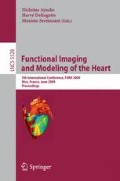Abstract
Vulnerability to atrial fibrillation (AF) is increased in acutely dilated atria and is related to stretch-activated channels (SACs). To investigate the role of atrial anatomy in AF, we apply a computer model of human atrial electromechanics that includes SACs and contraction of the sarcomeres. Trabecular bundle structures are modeled by varying atrial wall thickness in a triangular mesh representing the human atria. Vulnerability to AF is investigated by application of overall stretch, while stimulating near the pulmonary veins. Due to contraction of some areas, stretch increases in other areas, leading to a variation in effective refractory period (ERP). Onset and perpetuation of AF in our model is explained by an increased dispersion in ERP, conduction slowing, and local conduction block. Atrial contraction attributes to the termination of AF through mechanoelectric feedback. We conclude that onset and termination of AF episodes under stretch are related to atrial structure and mechanoelectric feedback.
Access this chapter
Tax calculation will be finalised at checkout
Purchases are for personal use only
Preview
Unable to display preview. Download preview PDF.
References
Bode, F., Katchman, A., Woosley, R.L., Franz, M.R.: Gadolinium decreases stretch-induced vulnerability to atrial fibrillation. Circulation 101, 2200–2205 (2000)
Bode, F., Sachs, F., Franz, M.R.: Tarantula peptide inhibits atrial fibrillation. Nature 409, 35–36 (2001)
Ravelli, F.: Mechano-electric feedback and atrial fibrillation. Progr. Biophys. Mol. Biol. 82, 137–149 (2003)
Satoh, T., Zipes, D.P.: Unequal atrial stretch in dogs increases dispersion of refractoriness conducive to developing atrial fibrillation. J. Cardiovasc. Electrophysiol. 7, 833–842 (1996)
Eijsbouts, S.C.M., Majidi, M., van Zandvoort, M., Allessie, M.A.: Effects of acute atrial dilation on heterogeneity in conduction in the isolated rabbit heart. J. Cardiovasc. Electrophysiol. 14, 269–278 (2003)
Kohl, P., Sachs, F.: Mechanoelectric feedback in cardiac cells. Phil. Trans. R Soc. Lond. 359, 1173–1185 (2001)
Henriquez, C.S.: Simulating the electrical behavior of cardiac tissue using the bidomain model. Crit. Rev. Biomed. Eng. 21, 1–77 (1993)
Kuijpers, N.H.L., Keldermann, R.H., Arts, T., Hilbers, P.A.J.: Computer simulations of successful defibrillation in decoupled and non-uniform cardiac tissue. Europace 7, S166–S177 (2005)
Kuijpers, N.H.L., Keldermann, R.H., ten Eikelder, H.M.M., Arts, T., Hilbers, P.A.J.: The role of the hyperpolarization-activated inward current \(\mbox{$I_{\mbox{\rm \tiny f}}$}\) in arrhythmogenesis: a computer model study. IEEE Trans. Biomed. Eng. 53, 1499–1511 (2006)
Courtemanche, M., Ramirez, R.J., Nattel, S.: Ionic mechanisms underlying human atrial action potential properties: insights from a mathematical model. Am. J. Physiol. Heart Circ. Physiol. 275, H301–H321 (1998)
van Dam, P.M., van Oosterom, A.: Atrial excitation assuming uniform propagation. J. Cardiovasc. Electrophysiol. 14 (suppl. 10), S166–S171 (2003)
Virag, N., Jacquemet, V., Henriquez, C.S., Zozor, S., Blanc, O., Vesin, J.M., Pruvot, E., Kappenberger, L.: Study of atrial arrhythmias in a computer model based on magnetic resonance images of human atria. Chaos 12, 754–763 (2002)
Kuijpers, N.H.L., ten Eikelder, H.M.M., Bovendeerd, P.H.M., Verheule, S., Arts, T., Hilbers, P.A.J.: Mechanoelectric feedback leads to conduction slowing and block in acutely dilated atria: a modeling study of cardiac electromechanics. Am. J. Physiol. Heart Circ. Physiol. 292, H2832–H2853 (2007)
Solovyova, O., Katsnelson, L., Guriev, S., Nikitina, L., Protsenko, Y., Routkevitch, S., Markhasin, V.: Mechanical inhomogeneity of myocardium studied in parallel and serial cardiac muscle duplexes: experiments and models. Chaos, Solitons and Fractals 13, 1685–1711 (2002)
Rice, J.J., Winslow, R.L., Hunter, W.C.: Comparison of putative cooperative mechanisms in cardiac muscle: length dependence and dynamic responses. Am. J. Physiol. Heart Circ. Physiol. 276, H1734–H1754 (1999)
Kuijpers, N.H.L., ten Eikelder, H.M.M., Bovendeerd, P.H.M., Verheule, S., Arts, T., Hilbers, P.A.J.: Mechanoelectric feedback as a trigger mechanism for cardiac electrical remodeling: a model study. Ann. Biomed. Eng. 36, 1816–1835 (2008)
Zabel, M., Koller, B.S., Sachs, F., Franz, M.R.: Stretch-induced voltage changes in the isolated beating heart: importance of timing of stretch and implications for stretch-activated ion channels. Cardiovasc. Res. 32, 120–130 (1996)
Haïssaguerre, M., Jaïs, P., Shah, D.C., Takahashi, A., Hocini, M., Quiniou, G., Garrigue, S., Le Mouroux, A., Le Métayer, P., Clémenty, J.: Spontaneous initiation of atrial fibrillation by ectopic beats originating in the pulmonary veins. New Engl. J. Med. 339, 659–666 (1998)
de Bakker, J.M.T., Ho, S.Y., Hocini, M.: Basic and clinical electrophysiology of pulmonary vein ectopy. Cardiovasc. Res. 54, 287–294 (2002)
Author information
Authors and Affiliations
Editor information
Editors and Affiliations
Rights and permissions
Copyright information
© 2009 Springer-Verlag Berlin Heidelberg
About this paper
Cite this paper
Kuijpers, N., ten Eikelder, H., Verheule, S. (2009). Atrial Anatomy Influences Onset and Termination of Atrial Fibrillation: A Computer Model Study. In: Ayache, N., Delingette, H., Sermesant, M. (eds) Functional Imaging and Modeling of the Heart. FIMH 2009. Lecture Notes in Computer Science, vol 5528. Springer, Berlin, Heidelberg. https://doi.org/10.1007/978-3-642-01932-6_31
Download citation
DOI: https://doi.org/10.1007/978-3-642-01932-6_31
Publisher Name: Springer, Berlin, Heidelberg
Print ISBN: 978-3-642-01931-9
Online ISBN: 978-3-642-01932-6
eBook Packages: Computer ScienceComputer Science (R0)

